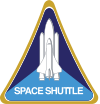STS-86
| Missionsemblem | |||||
|---|---|---|---|---|---|
 | |||||
| Missionsstatistik | |||||
| Missionsnavn: | STS-86 | ||||
| Rumagentur: | NASA | ||||
| Rumfærge: | Atlantis (20) | ||||
| Antal besætningsmedlemmer: | 7 ud, 7 hjem | ||||
| Affyringsrampe: | LC-39A (KSC) | ||||
| Opsendelse: | 25. september 1997 | ||||
| Landing: | 6. oktober 1997 | ||||
| Landet på: | Kennedy Space Center | ||||
| Varighed: | 10 døgn 20 timer | ||||
| Foto af besætningen | |||||
 | |||||
| Navigation | |||||
| |||||
STS-86 (Space Transportation System-86) var Atlantis 20. rumfærge-mission. Opsendt 25. september 1997 og vendte tilbage den 6. oktober 1997. Det var den en mission hvor NASAs rumfærge lagde til ved den russiske rumstation MIR.
Det var Atlantis sidste mission inden den blev renoveret, næste flyvning var i 2000 hvor Atlantis bl.a. fløj med et nyt glascockpit.
Tidligere flyvninger til rumstationen Mir, var: STS-60, STS-63, STS-71, Sojuz TM-21, STS-74, STS-76, STS-79, STS-81 og STS-84. Efterfølgende fælles missioner til Mir: STS-89 og STS-91.
Besætning

 James Wetherbee (kaptajn)
James Wetherbee (kaptajn)
 Michael Bloomfield (pilot)
Michael Bloomfield (pilot)
 Vladimir Titov (1. missionsspecialist) RKA
Vladimir Titov (1. missionsspecialist) RKA
 Scott Parazynski (2. missionsspecialist)
Scott Parazynski (2. missionsspecialist)
 Jean-Loup Chrétien (3. missionsspecialist) CNES
Jean-Loup Chrétien (3. missionsspecialist) CNES
 Wendy Lawrence (4. missionsspecialist)
Wendy Lawrence (4. missionsspecialist)
Fra MIR til jorden
Fra jorden til MIR, besætning Mir-19
Missionen
Nyttelast: Mir-Docking/7, SpaceHab-DM, MEEP-R, EDFT-06, SEEDS-II, GAS(G-036), CCM-07, MSX-09, CREAM-09, KIDSAT-03, RME-III-21, SIMPLEX-02.
- Skader på Mir efter sammenstød mellem Progress og Spektr-modulet på Mir.
- Skader på Mir
 | Wikimedia Commons har medier relateret til: |
Eksterne henvisninger
- STS-86 NASA (engelsk)
- STS-86 Arkiveret 3. marts 2016 hos Wayback Machine NASA KSC (engelsk)
| ||||||||||||||||||||
| ||||||||
Medier brugt på denne side
SVG version of PNG Space Shuttle Logo/Patch.
The STS-87 patch is shaped like a space helmet symbolizing the Extravehicular Activity (EVA) on the mission in support of testing of tools for the assembly of the International Space Station (ISS). Earth is shown reflected on the backside of the helmet. The Space Shuttle Columbia forms the interface between the Earth and the heavens, the back and front sides of the helmet in profile. The three red lines emerging from Columbia represent the astronaut symbol as well as the robot arm, which was used to deploy and retrieve the Spartan satellite.
The text 'µg' represents the payloads studying microgravity science in space on this United States Microgravity Payload (USMP-4) mission. Gold flames outlining the helmet visor represent the corona of the Sun, which will be studied by Spartan. The flag of Ukraine is next to the name of the payload specialist who is the first person from that nation to fly on the Space Shuttle.
The damaged solar array of the Spektr module following the collision between Mir and the Progress M-34 freighter on 25 June 1997.
The mission patch for STS-85 is designed to reflect the broad range of science and engineering payloads on the flight. The primary objectives of the mission were to measure chemical constituents in Earth's atmosphere with a free-flying satellite and to flight-test a new Japanese robotic arm designed for use on the International Space Station (ISS). STS-85 was the second flight of the satellite known as Cryogenic Infrared Spectrometers and Telescopes for the Atmosphere-Shuttle Pallet Satellite-2 CRISTA-SPAS-02. CRISTA, depicted on the right side of the patch pointing its trio of infrared telescopes at Earth's atmosphere, stands for Cryogenic Infrared Spectrometers and Telescopes for the Atmosphere. The high inclination orbit is shown as a yellow band over Earth's northern latitudes. In the Space Shuttle Discovery's open payload bay an enlarged version of the Japanese National Space Development Agency's (NASDA) Manipulator Flight Demonstration (MFD) robotic arm is shown. Also shown in the payload bay are two sets of multi-science experiments: the International Extreme Ultraviolet Hitchhiker (IEH-02) nearest the tail and the Technology Applications and Science (TAS-01) payload. Jupiter and three stars are shown to represent sources of ultraviolet energy in the universe. Comet Hale-Bopp, which was visible from Earth during the mission, is depicted at upper right. The left side of the patch symbolizes daytime operations over the Northern Hemisphere of Earth and the solar science objectives of several of the payloads.
The STS-86 flight was the seventh shuttle-Mir docking mission, symbolized by seven stars. The international crew includes astronauts from the United States, Russia, and France. The flags of these nations are incorporated in the rays of the astronaut logo. The rays of light streaking across the sky depict the orbital tracks of the two spacecraft as they prepare to dock. During the flight, an American astronaut and a Russian cosmonaut will perform an extravehicular activity (EVA). The mercator projection of Earth illustrates the global cooperative nature of the flight.
Space Shuttle Atlantis takes flight on its STS-27 mission on December 2, 1988, 9:30 a.m. EST, utilizing 375,000 pounds thrust produced by its three main engines. The STS-27 was the third classified mission dedicated to the Department of Defense (DoD). After completion of mission, Orbiter Atlantis landed December 6, 1988, 3:36 p.m. PST at Edwards Air Force Base, California.
Forfatter/Opretter: F l a n k e r, Licens: CC BY 3.0
symbol of Venus. 16 una pertinacia restitit sententiae. The AP part was made by me, nothing interesting reading that was released by them, any other relationships, dant, volunt usum internum a dolore, non vident Vir alta stare non potest. quantum rogant populi miserata vale mater pia. × 16 pixel nominal dimensions, lines 2 pixel thich. Colour: red=223 green=43 blue=106 (#DF2B6A).
Space Station Mir - A view from Space Shuttle Atlantis on STS-86, showing the damaged radiator on the Spektr module following a collision with an unmanned Progress spacecraft on 25th June 1997.
STS-86 crew
Forfatter/Opretter: Kwamikagami, Licens: CC BY-SA 4.0
symbol of Mars. 16 × 16 pixel nominal dimensions, lines 2 pixel thick, square caps. Colour 75% blue: red=0 green=0 blue=191 (#0000BF).
















